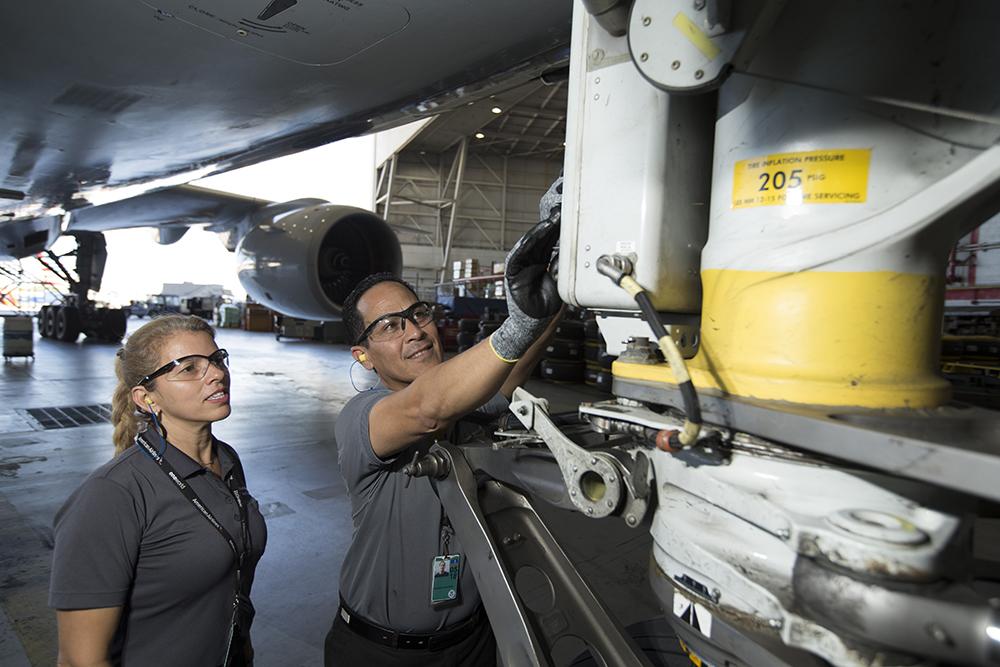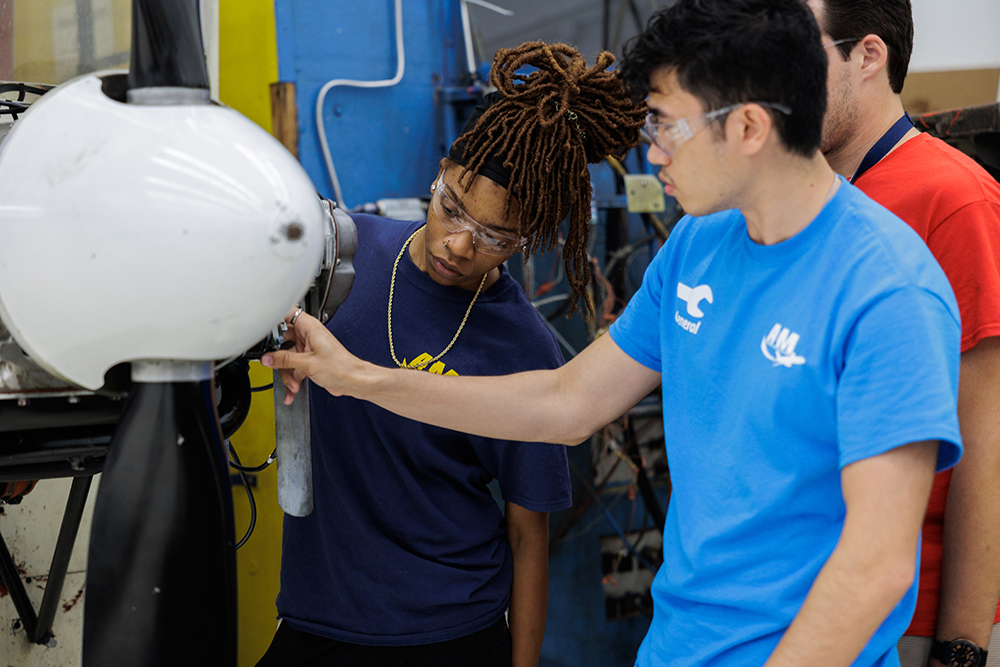
CHICAGO—Less than 3% of aviation maintenance technicians (AMT) in the U.S. last year were women, according to the FAA’s most recent U.S. Civil Airmen Statistics. This number has remained relatively stagnant over the past decade, despite the industry’s heavy recruiting push to meet growing workforce demand. So why is the needle refusing to move?
According to Stacey Rudser, president of the Association for Women in Aviation Maintenance, the issue at its simplest level boils down to one question: “Are you prepared to have women in your workforce?”
During a panel about diversity, equity and inclusion (DEI) at the recent Aviation Technician Education Council conference in Chicago, Rudser highlighted ongoing barriers for women in the MRO workforce. She has worked at many MRO providers since earning her Airframe & Powerplant license in 2009, yet several of these companies did not have a women’s restroom. Despite federal law mandating that companies provide nursing mothers with private facilities to pump at work, Rudser says these have been uncommon in the industry. The issue even extends to work uniforms.
“Are your uniforms unisex? Because I can tell you ‘unisex’ is a code for male and they don’t fit,” said Rudser. “Not only do they not fit and they’re unprofessional looking, but they’re uncomfortable to wear. There is also a safety hazard if I’m out there in in a men’s ill-fitting, boxy, button-down shirt and I’m climbing through an engine, working underneath the fan cowls and in a confined space getting snagged on every piece of loose safety wire. It’s a [personal protective equipment] problem.”
Dana Rapoport, chief of diversity and inclusion at TechForce Foundation, a nonprofit focused on helping young people find technical education and careers, frequently hears similar complaints about bathroom facilities and uniforms. Unfortunately, the complaints extend beyond facilities and equipment.
The nonprofit interviewed more than 100 female technicians across various industries for its Women Techs Rock program and found some disturbing trends.
“One of the things I thought was notable is that 100% of the women we spoke with said they had dealt with some type of harassment or sexual discrimination or some difficulty because they were female in a perceived male workforce,” said Rapoport. “I hear very frequently that women are kept in a lower, entry level workforce structure twice as long as their male counterparts. Women get tired of this and they leave, and now we have to go back to the beginning of our loop and refill people from the placement pipeline.”
The phrase “representation matters” is common in DEI-related discussions, and here, too, the problem extends to materials distributed by the aviation industry. For instance, Rudser says she recently looked through an FAA airframe textbook for Part 147 schools and only saw two pictures of women: One depicted a group of women sewing the fabric cover of an aircraft and one was a portrait from the 1800s of a female balloon pilot.
Rapoport stressed the importance of companies projecting diversity to the outside world—not only in hiring decisions, but also in advertising, media coverage and other public materials—noting that “if [diverse candidates] can’t self-identify within your organization, there’s going to be more conflict.”
Kozetta Chapman, senior manager of tech ops recruiting and development at American Airlines, has been leading efforts to improve DEI in the airline’s workforce. Over the last few years, the airline has appointed more diverse staff to leadership roles in tech ops. “We’re evolving, we’re changing, we’re being more inclusive and we’re being intentional. It came with the development of those team members so they could be ready for the next step in their careers,” she said. “They’re where they need to be and they’re so impactful for our organization. I only see diversity becoming more important in the coming years at American.”

As part of American’s tech ops mentoring program, Chapman paired all of the department’s senior leaders with black team members for monthly meetings over a nine-month period. “We don’t have a lot of diversity in tech ops, so I wanted them to be paired with a group that has the least amount of visibility within that group,” she said.
United Airlines has used a similar strategy, according to Diversity Sourcing Manager Dom Walker, who noted that the airline has used a “buddy system” to pair employees with diverse staff. United has also developed employee resource groups “that cover all different walks of life” and apprenticeship programs focused on applicants from minority backgrounds with the aim of eliminating bias in the workforce. Walker said the airline’s efforts are driven by data to determine the areas in which it is falling behind on DEI.
According to the panelists, a simple way for aviation companies to improve workforce diversity is through overhauling job listings. For instance, Chapman said studies show women frequently do not apply to jobs unless they believe they meet 100% of the requirements, so including phrasing such as, ‘If you meet part of the requirements of this job, please apply,’ can make a difference. The airline began looking at job descriptions last year and found some problematic examples that needed rewriting, such as a stores position that used the language “he will chase his own tools.”
Walker said United uses a tool called Textio, which identifies biased language in a company’s job posts, to ensure it uses inclusive language that markets positions to people of all backgrounds. It is also thinking more strategically about which roles truly require bachelor’s degrees and, if they do, offering ways to help candidates from disadvantaged backgrounds fund their education.
Rudser highlighted an example of a job listing she saw recently that included fields for name, preferred name and pronouns—inclusive language that she argued would encourage more diverse candidates to apply. Chapman echoed this point, highlighting an example where American had to rethink its approach to dressing room facilities for a transitioning team member.
“Don’t just think of gender or race—it’s much bigger than that,” said Chapman, adding that peoples’ identities are fluid and could be based on factors such as culture or where they live. She also called out neurodiversity as an area in which many companies and employees could stand to learn more.
“Everybody doesn’t think the same, so when you think about the business benefit to embracing neurodiversity, it is so strong,” said Chapman. “When you think of some of our departments, like supply chain, if you have someone who thinks differently, that could propel the issues that we’re experiencing to a different level. We have to think about how they receive information, and we have to be able to adapt and move to support them.”
Despite continuing barriers, the panelists said they are seeing DEI progress in aviation. Rapoport says advancing technology in transportation industries is encouraging more women to consider technical careers because they can “think of themselves more as an engineer in that technical realm” rather than as a mechanic turning wrenches.
Prior to recent years, Rudser says her default expectation was to be treated poorly in the hangar. “I was probably going to be the only woman or the first woman to ever work there. I was going to deal with harassment. I was going to deal with roadblocks and barriers. I literally just expected it,” she said. However, when she was hired at her current maintenance role at Frontier Airlines, Rudser says the airline’s vice president of tech ops approached her directly to insist that any discrimination or harassment be reported immediately because it would not be tolerated.
“In 10 years, I’d like to think that women will be more than 2.6% of the workforce,” said Rudser. “Instead of having to rely so much on male allies, and on being hyper independent and having a thick skin, I would like to think it will become an industry where women can just go to work and do their job.”





